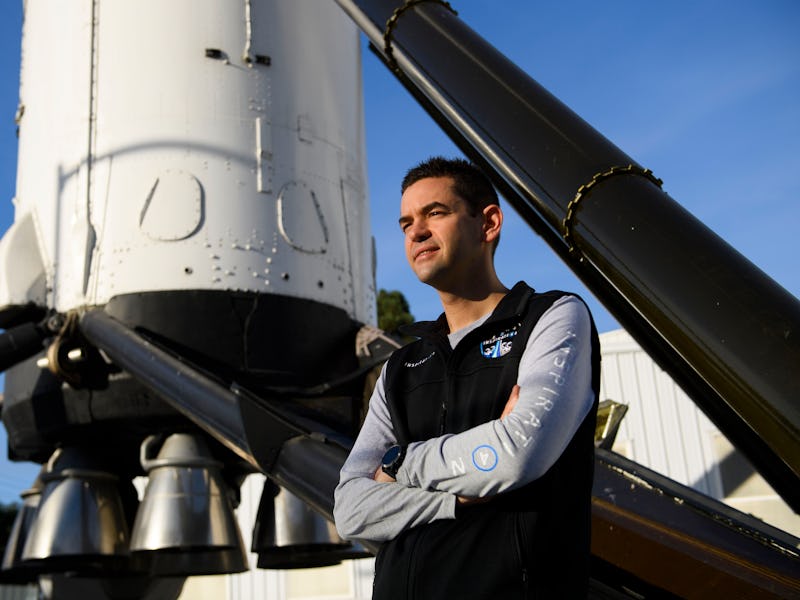SpaceX’s Polaris mission could kickstart a new era for private spaceflight
The first private spacewalk!

In September 2021, Jared Isaacman and three crew members went for a private ride on a SpaceX Crew Dragon rocket and made history. The Inspiration4 mission was the first all-civilian private spaceflight to make it to orbit. Clearly, Isaacman was inspired: Now the private space patron is going with SpaceX farther than any other player in the industry has gone before — and perhaps even break an orbital flight record along the way.
On Monday, February 14, Isaacman and SpaceX revealed three new private space missions, which they are calling Polaris. The Shift4 payments service founder wants to use Polaris to beat a 56-year-old spaceflight record. In 1966, astronauts Pete Conrad and Charles Gordon flew the Gemini 11 mission 856 miles above Earth, the highest Earth-orbit ever achieved (though the Apollo program clearly went manyfold further to the Moon.)
Polaris could also involve the first crewed, orbital flight for SpaceX’s long-in-development Starship — a vital step for the rocket to become a viable means of transporting humans to more distant points in space, like the Moon or Mars.
Here’s everything you need to know about the Polaris program, which is broken down into three missions:
Polaris missions: Crew, objectives, and timeline
Polaris Dawn — The first mission, Polaris Dawn, involves Isaacman returning to space with SpaceX employees, Sarah Gillis and Anna Menon, and Scott Poteet, an Air Force pilot who served as mission director for Inspiration4. Also in keeping with Inspiration4, Polaris Dawn will involve a fundraiser for St. Jude Children’s Research Hospital.
This five-day mission will attempt to “reach the highest Earth orbit ever flown” and potentially involve the first-ever private spacewalk. The commercial astronauts will also conduct a series of scientific and medical experiments and test a Starlink laser meant to enable higher-bandwidth communication with Earth.
This mission will launch in the fall or early winter of 2022 at the earliest. The Polaris Dawn mission will launch from Launch Complex 39A at the Kennedy Space Center in Florida. This pad saw the launch of the majority of the Apollo missions to the Moon and is often used by SpaceX for its missions.
Mission II — This mission will “continue to expand the boundaries of future human spaceflight missions, in-space communications, and scientific research” as a follow-on to Polaris Dawn, according to the Polaris website. There is no target launch date.
Mission III — In this segment, a fleet of private astronauts will undertake the first crewed voyage of SpaceX’s Starship, a reusable spacecraft that is designed to ferry humans to the Moon and Mars, but which has yet to complete a successful orbital test. There is no target launch date.
Polaris Dawn: How it will help SpaceX
The Polaris Dawn mission promises SpaceX the bragging rights of setting a new spaceflight record. It will also enable the private space company to test two pieces of critical hardware:
- SpaceX spaceflight suits: The company designed its own spacesuits to support extravehicular activity, which can involve anything from Moon landings to in-flight repairs. The SpaceX suits are less bulky than those used by NASA and may even be (unsurprisingly to those who follow Musk) inspired by a video game. Right now, we don’t know much about what activity the Polaris Dawn mission will use these suits for. But because there isn’t a staging area within the Crew Dragon vehicle — so nowhere to hide from the vacuum of space — it’s likely the entire cabin will be depressurized during whatever activity does take place.
- Starlink communications laser: SpaceX is working on a laser communications system for Starlink, its satellite internet service. Laser communications can beam data directly in between satellites with little data loss. This will be the first test of the technology in space.
In addition, the crew will conduct several medical experiments, including:
- Study decompression sickness via ultrasound, monitoring levels of venous gas emboli (essentially gas bubbles that form in veins and interfere with blood flow and can cause fatalities).
- Gather data on the effects of space radiation — especially relevant as the team will cross the Van Allen radiation belt, which is a region of space where streams of highly-charged particles, mostly caused by solar wind, form a band in the Earth’s magnetosphere. You need to cross the Van Allen radiation zone to get to the Moon, so humans have done this before.
- Provide medical samples to be stored for future analysis — this will help us understand the long-term effects of spaceflight.
- Study spaceflight-associated neuro-ocular syndrome, a condition reported by astronauts that affects vision long-term and is one of the greatest known barriers to long-duration spaceflight.
The Polaris Dawn crew: Member bios
The four-person crew will consist of:
- Jared Isaacman: Founder of Shift4 payment systems. Isaacman has a vested interest in aerospace, including operating Draken International, which trains military pilots. Isaacman’s Inspiration4 flight made history as the first privately crewed, privately commissioned orbital spaceflight.
- Sarah Gillis: Lead operations engineer at SpaceX. Gillis started at the company in 2015 as an intern and has made her way up the ladder. She was intimately involved in the day-to-day of Inspiration4. Gillis is the mission specialist for Polaris Dawn.
- Anna Menon: Lead space operations engineer at SpaceX. Menon will serve as the medical officer aboard the mission. Menon has been involved with SpaceX for several years. Her husband, Anil Menon, who also once worked at SpaceX, was recently selected by NASA as an astronaut candidate.
- Scott Poteet: He was mission director for Inspiration4. He will be the pilot for the Polaris Dawn mission. Poteet, an Air Force veteran, has worked closely with Isaacman as a former director of business development at Draken and V.P. of business strategy at Shift4. He goes by the nickname “Kidd”.
This article was originally published on